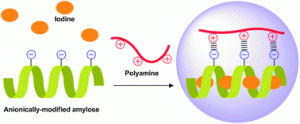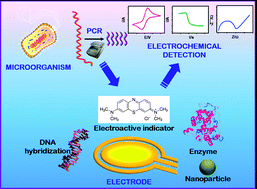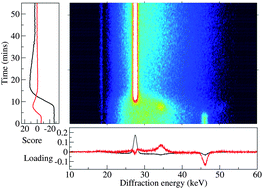A team from Japan report that biological polyamines can be detected by a colorimetric sensing method based on a stimuli-responsive inclusion complex of anionically-modified amylose. Polyamines play a key role in cellular processes and increased levels in the urine can indicate a cancer diagnosis. Current polyamine detection methods are time-consuming and costly so development of a convenient sensing method is important.
 The “iodo-starch reaction”, involving the encapsulation of iodine by amylose resulting in a blue or purple colour, has long been used for the detection of starch and iodine. Yasumasa Kanekiyo and co-workers from the Kitami Institute of Technology in Japan describe the development of a simple, functional and eco-friendly sensing method for polyamines in this HOT Article.
The “iodo-starch reaction”, involving the encapsulation of iodine by amylose resulting in a blue or purple colour, has long been used for the detection of starch and iodine. Yasumasa Kanekiyo and co-workers from the Kitami Institute of Technology in Japan describe the development of a simple, functional and eco-friendly sensing method for polyamines in this HOT Article.
The group synthesised amylose modified with carboxyl groups and demonstrated that an aqueous solution of the modified amylose and iodine was clear due to the disruption of the inclusion complex by electrostatic repulsion between the anionic carboxylate groups and polyiodide. Upon addition of spermine (a polyamine) the solution clearly changed to bluish purple. The colour change was attributed to the encapsulation of iodine into the helical cavity of amylose, triggered by the electrostatic association between the amylose and spermine.
Interested in knowing more? Read for free here until 10th March!
Colorimetric sensing method for polyamines utilising an inclusion complex of stimuli-responsive amylose
Masayuki Tsuchiya, Yuta Nomiyama, Wakana Takayoshi, Yuto Iwami and Yasumasa Kanekiyo
Anal. Methods, 2011, Advance Article, Paper
DOI: 10.1039/C0AY00690D
 In this Critical Review, José M. Pingarrón, María Pedrero and Susana Campuzano from the University Complutense of Madrid review the use of DNA electrochemical sensors combined with PCR-amplification strategies for the detection of microorganisms. They show that PCR-amplified DNA hybridization electrochemical sensors exhibit a high sensitivity which is attributable not only to PCR-amplification but also to the detection approaches used.
In this Critical Review, José M. Pingarrón, María Pedrero and Susana Campuzano from the University Complutense of Madrid review the use of DNA electrochemical sensors combined with PCR-amplification strategies for the detection of microorganisms. They show that PCR-amplified DNA hybridization electrochemical sensors exhibit a high sensitivity which is attributable not only to PCR-amplification but also to the detection approaches used.











